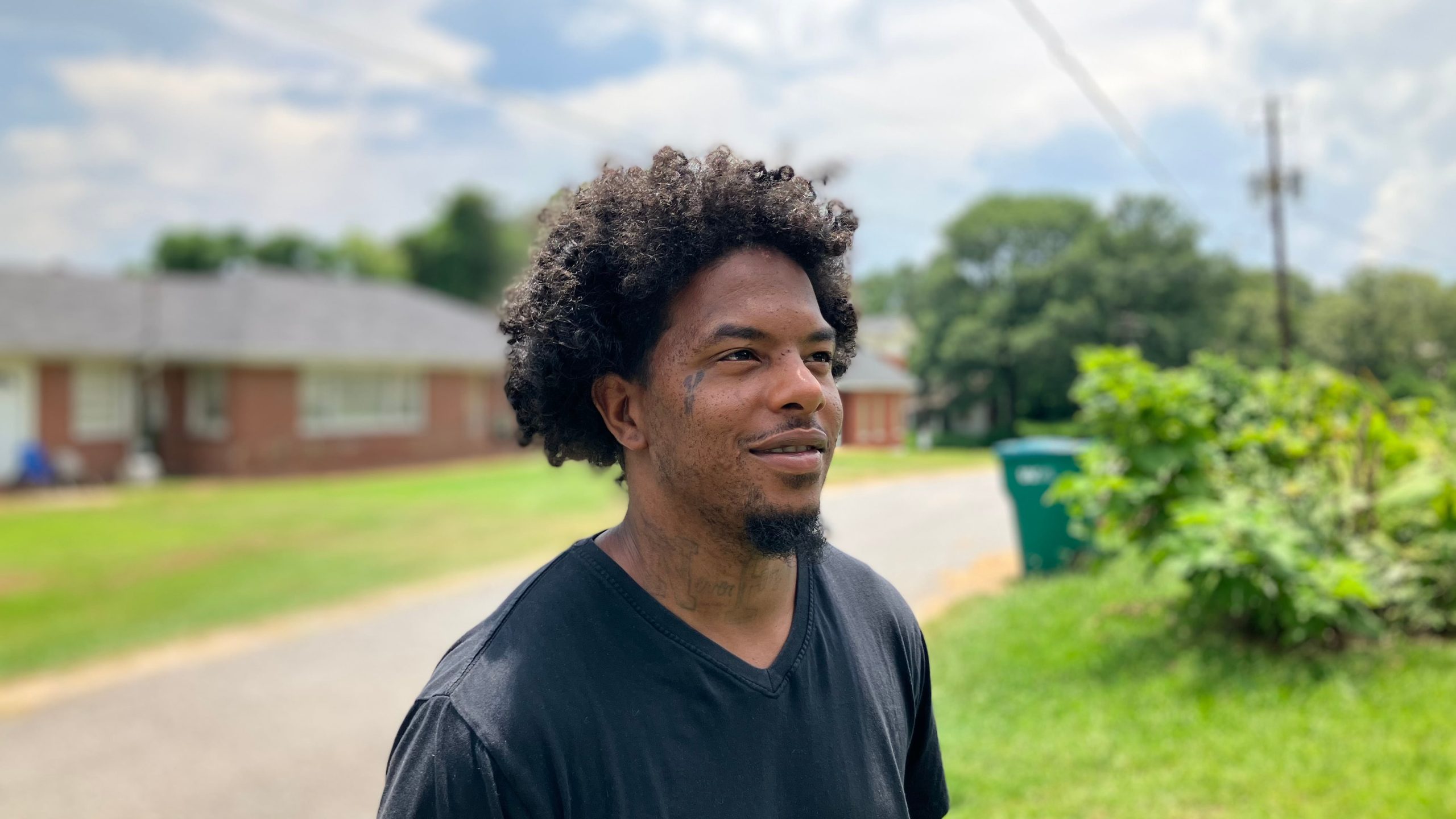‘We’re still struggling’: How an Alabama town is fighting to rebuild years after disaster
After a severe hailstorm devastated his small Alabama town in 2023, Johntavius Doss got to work repairing his neighbors’ homes.
But two years later, Doss and his family of six still live with a blue tarp covering their roof, waiting for the day that life returns to normal.
“It’s been rough out here…Floors falling in, every time I fix something, something’s tearing up, and when it rains, it pours,” said Doss, a lifelong resident of Camp Hill. “The whole roof is tarped, the wiring, the plumbing, it’s everything.”
Camp Hill, with its towering trees and historic homes, is a predominately Black town in east-central Alabama. Located about 30 miles from the Georgia line, it’s home to just over 1,000 people, many of whom are seniors.
The residents of this small town talk about their lives in two ways: Before the storm and after the storm.
Juanita Woody, a longtime government leader in Camp Hill, told AL.com about 50 homes are still damaged. Many people are still living with tarps or plastic covering their roofs and windows because recent federal funding cuts halted the repair work that had started.
Johntavius Doss helped to repair his neighbors’ homes after the hailstorm. Alaina Bookman | [email protected]
Doss, who rents his home, said his rent continues to increase, despite the deterioration. He is also paying to keep his grandmother in a nursing home until he can afford a safer house.
The financial burden continues to pile up.
“Before the storm, we were functioning really well,” Woody said. “All that changed on that day.”
The storm
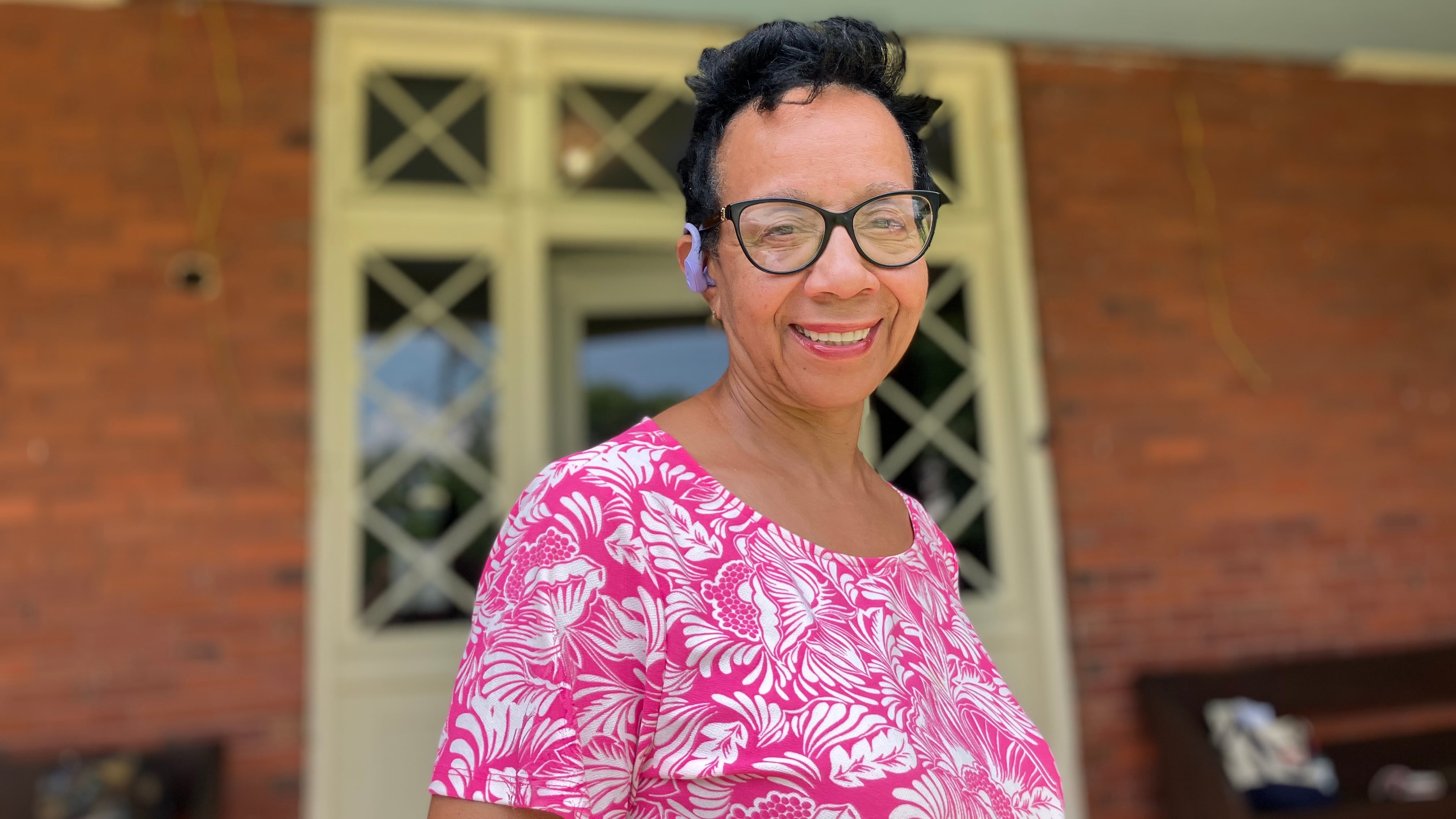
Juanita Woody, a top government official in Camp Hill, said residents are still struggling two years after the storm. Alaina Bookman | [email protected]
Woody said she remembers hearing the hail pelt her home at 3 a.m. on March 26, 2023.
“It was frightening,” Woody told AL.com.
She knew the effects would be devastating, but it wasn’t until the sun rose that morning that she realized just how much damage had been done.
On the night of the storm, high winds and baseball-sized hail battered roofs, shattered windows and destroyed homes.
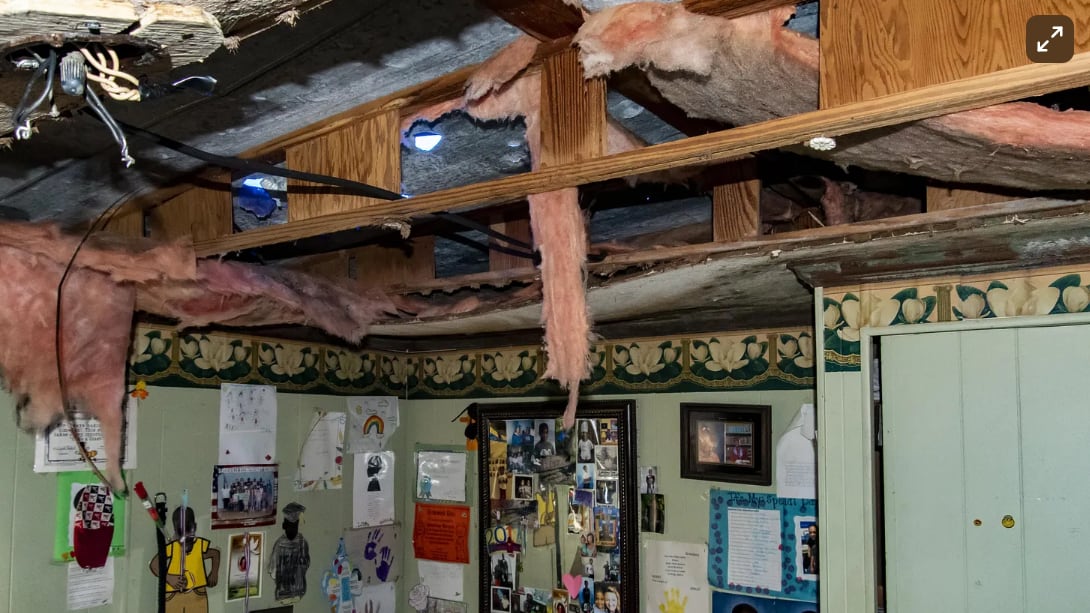
The hailstorm caused severe damage to homes across Camp Hill. Courtesy of Lee Hedgepeth
In a community where there is no grocery store and many drive out of town for work, windshields, windows and mirrors were shattered on cars all across town.
“We were at a standstill…It rained early that Sunday morning, it rained that Monday, and it also rained on Tuesday,“ Woody said. “So here we were, holes in our homes and our windows, and it’s literally raining in our houses, raining in our cars.”
“That day changed everything in Camp Hill…From that day to now, we’re still struggling with the hailstorm.”
Despite the significant damage, Camp Hill was denied FEMA assistance for individuals. If President Biden had issued a formal declaration, that would have trigged federal assistance for the residents.
While FEMA did provide public assistance for debris removal, emergency protective measures, and public infrastructure repairs, it left many residents, specifically those without insurance, struggling to recover.
The Regional FEMA office said the impact from the storm “was not such severity and magnitude to warrant the designation of Individual Assistance,” according to reports from the Alabama Reflector.
“That day changed everything in Camp Hill…From that day to now, we’re still struggling with the hailstorm.”
Juanita Woody, mayor pro-tem in Camp Hill
Despite not technically meeting the requirements laid out by FEMA, Camp Hill residents say they still need help.
And the storm was not the only tragedy to hit the town that spring.
The mass shooting
On April 15, 2023, less than a month after the hailstorm, a mass shooting killed Philstavious Dowdell, an 18-year-old promising high school athlete from Camp Hill.
The shooting happened at a birthday party for his sister, Alexis Dowdell. There aren’t many venues for a 16th birthday celebration in Camp Hill, so they threw the party at a dance studio in nearby Dadeville.

Dadeville High School senior Philstavious Dowdell was killed in a mass shooting. Prior to the shooting, he had committed to play football at Jacksonville State. Henry Zimmer | Alex City Outlook
Many of the attendants were from Camp Hill. The towns sit less than 10 miles apart, just off U.S. 280, about 20 miles northwest of Auburn.
In all, four people died and 32 others were injured, disrupting the promising futures of many young people in Camp Hill.
Jesse Francis said his family was still trying to recover from the hailstorm when his stepson, KD, was shot and paralyzed.
KD, a high school senior at the time, had earned a scholarship to play football, Francis said.
The shooting took all of that away.
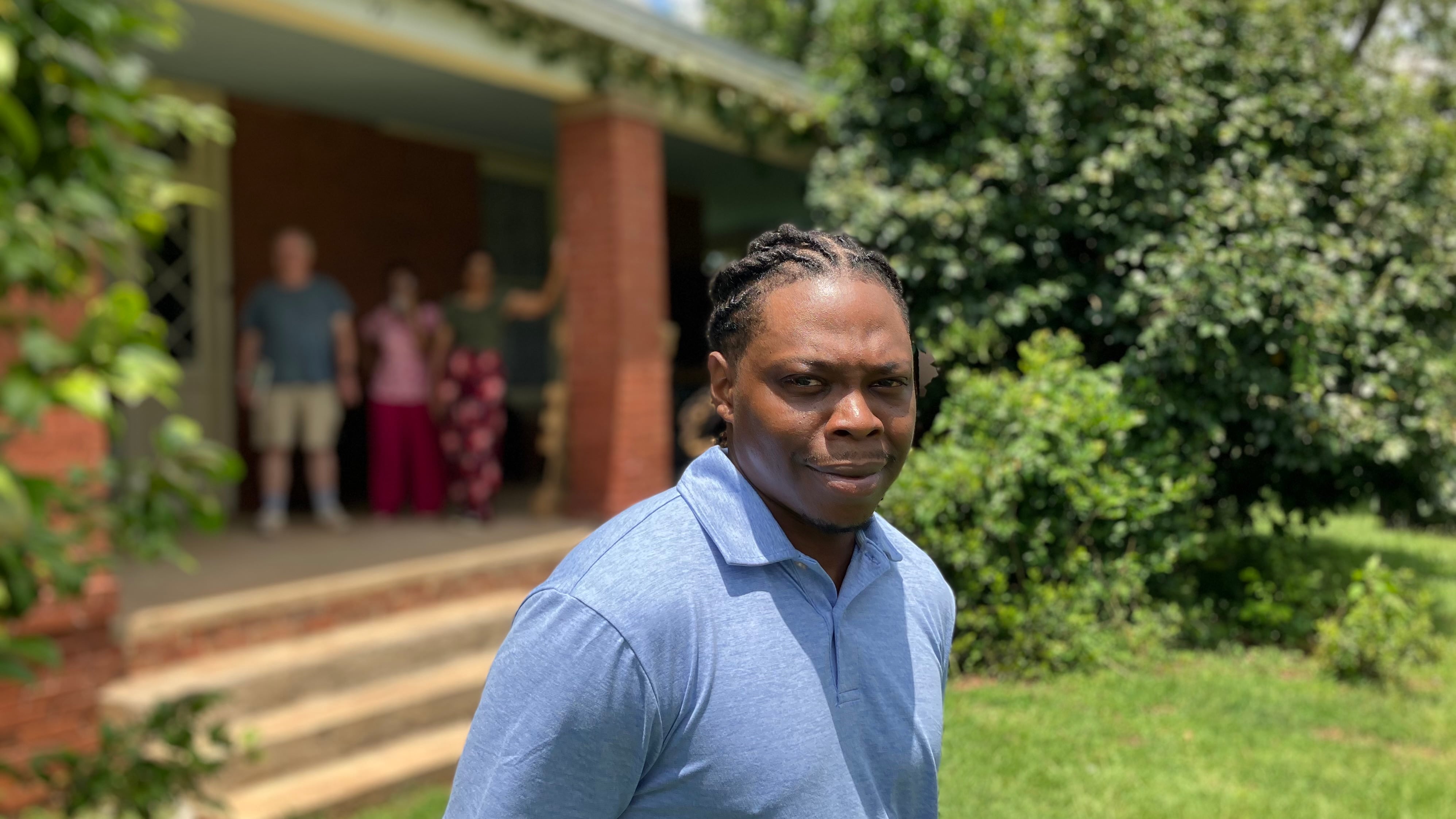
After the storm destroyed his family’s home, Jesse Francis’ stepson was shot and paralyzed during a mass shooting in Dadeville. Alaina Bookman | [email protected]
The family lived in an RV, so KD had to move in with his grandparents during his recovery. And the family suffered another heartbreak when his grandfather died recently.
“With him being injured, it was so stressful because when it first hit him, oh man, you had to keep your eyes on him,” Francis said. “You didn’t know what he was thinking. He was so emotionally distressed. We went through a lot over the years.”
To this day, Francis said, he and his family are still waiting for help.
A community that came together
After the storm, the community immediately got to work, tarping roofs, covering windows and donating food.
“We all came together because we were all hurting,” Woody said.
Residents like Peggy Thomas jumped into action, helping to stock the shelves of the community food pantry. To this day, she still volunteers, giving out food to the residents every week.
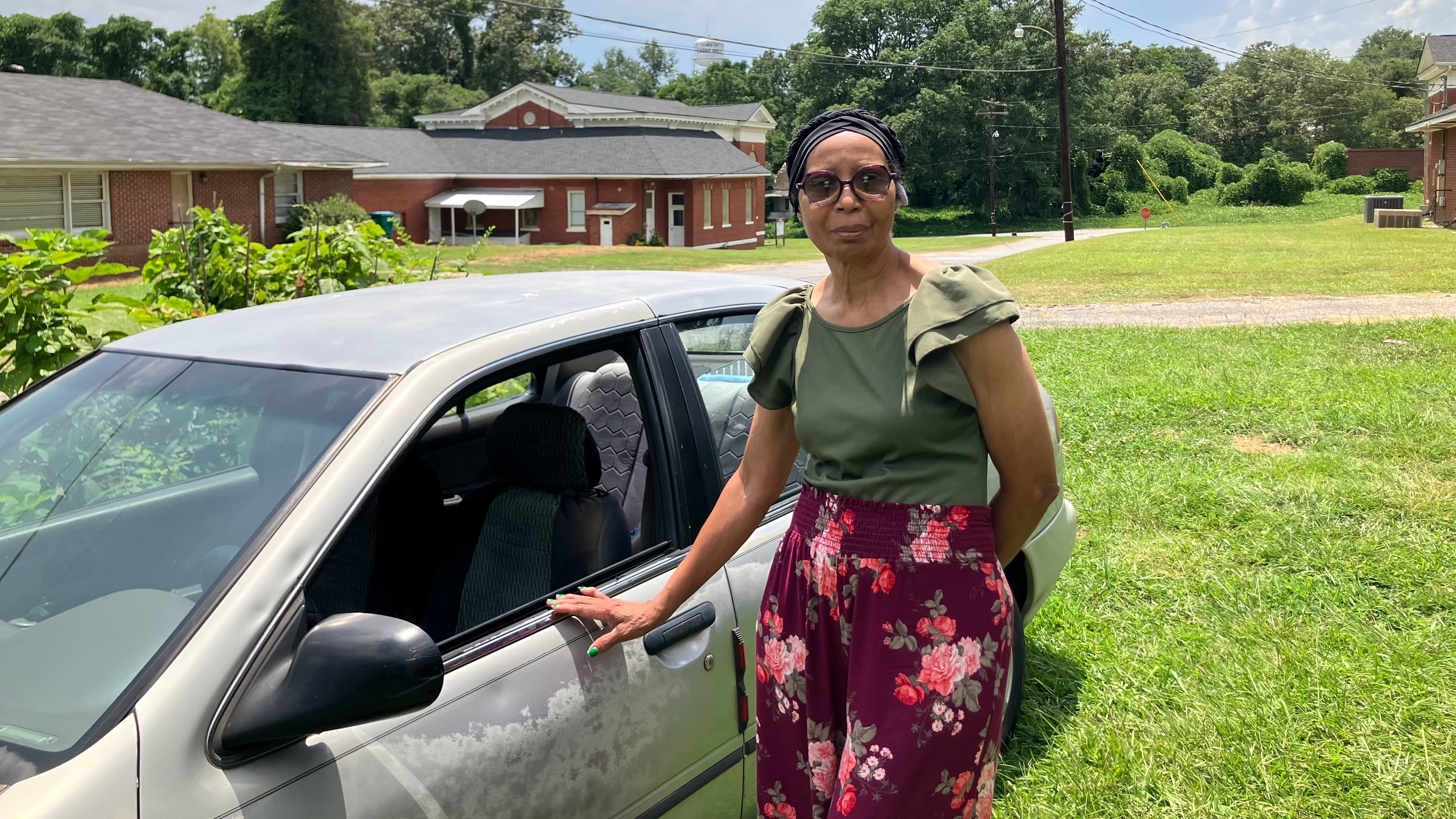
Peggy Thomas jumped into action after a hailstorm devasted Camp Hill in 2023. Alaina Bookman | [email protected]
“They said they needed help, so I’ve been helping ever since,” Thomas said. “We’re like one big, happy family here. If anyone needs something, we will help.”
Warren Tidwell, an activist and humanitarian from Jasper, has spent more than 20 years helping rural towns after natural disasters. From Hurricane Katrina to tornadoes in Alabama, he’s been there.
“I saw this massive gap in disaster response long term within rural places,” Tidwell said.
“The immediate aftermath is tough. The grueling, unrelenting, hard work of long-term recovery that attempts to get a community back to some semblance of normality is something that is even more difficult.”
In 2023, Tidwell founded a nonprofit helping rural Alabama towns rebuild after natural disasters, which is taking donations to help Camp Hill.
“I gave these folks my word. I told them that I was going to be with them through thick and thin,” Tidwell said. “In the two years since, we have done a lot with very little resources.”
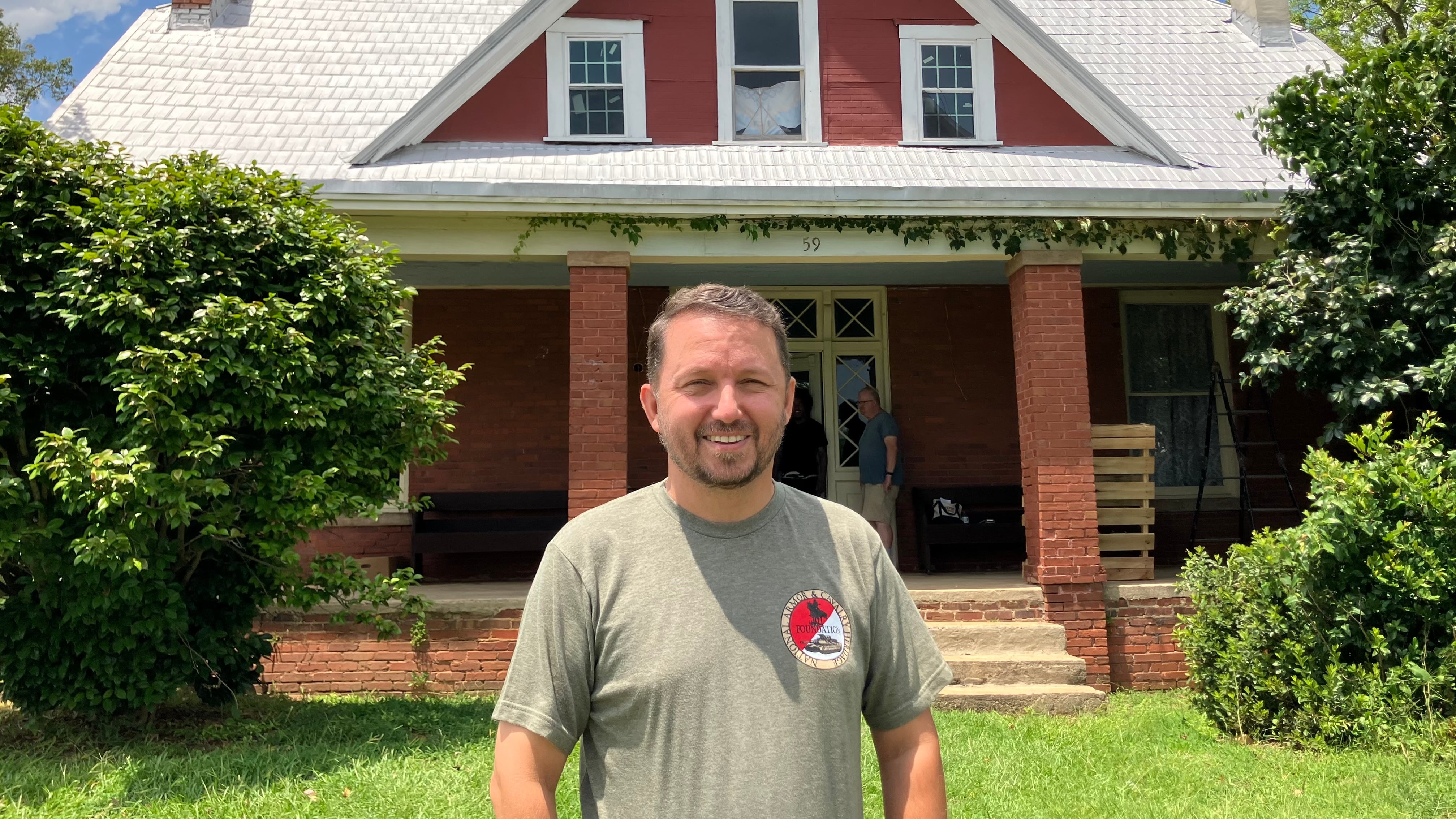
Warren Tidwell founded a nonprofit to help rebuild Camp Hill. Alaina Bookman | [email protected]
The nonprofit, called ACROSS, brought in over a million dollars worth of donations to Camp Hill, including 500,000 meals and more than $50,000 in tarps.
They created a community kitchen which served 7,000 hot meals in the months after the storm.
They also established an education and assistance program to help residents apply for government help from FEMA and USDA to, among other things, protect their properties.
They did all that and more with only $7,800 and donations.
But there was still much more work to be done. And they just didn’t have the resources.
The repairs that never came
In 2024, ACROSS partnered with Groundswell, an organization helping make communities and homes more energy efficient. Groundswell secured the EPA Community Change Grant which would help ACROSS continue repairing homes in Camp Hill.
Tidwell and local leaders began to spread the news to community members who were waiting desperately for help. The money was expected to arrive early this year.
But that help never came. Trump Administration federal funding cuts arrived first.
“We were so ecstatic when they were awarded that multimillion-dollar federal grant that would have helped us fix all of our worst cases,” Tidwell said.
“So we were extremely disheartened when, in January, the federal freeze came down, and we realized that they had been caught up in that and there was no guidance. No one knew exactly what was going on…Not getting the homes fixed was gut wrenching.”
The next blow hit other critical resources the town needed. Cuts to the USDA impacted the Food Bank of East Alabama, which limited nutritional options for Camp Hill.
The cuts ended up stalling all repair work in the town.
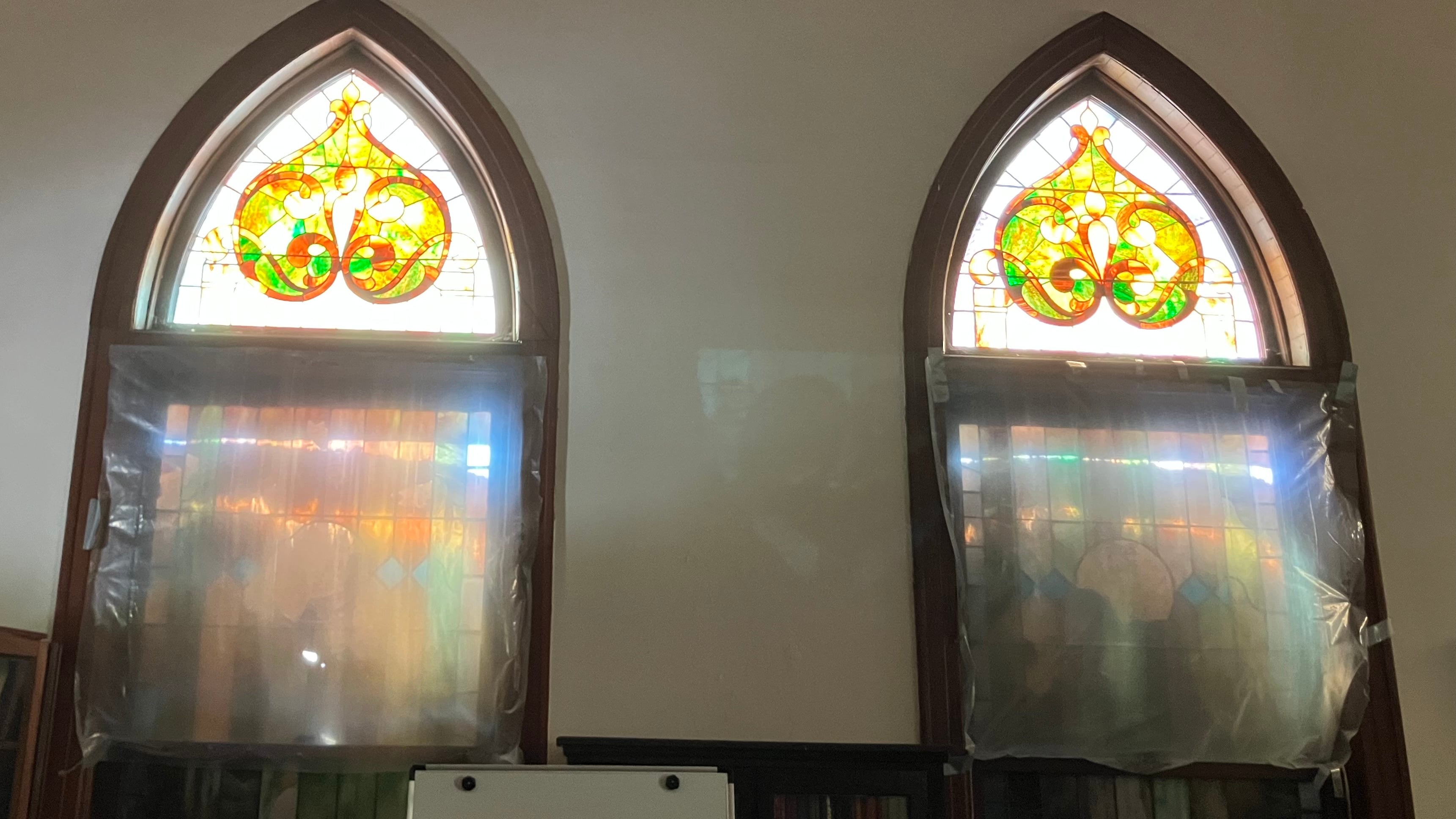
First Universalist Church of Camp Hill still has signs of damage from the hailstorm. Alaina Bookman | [email protected]
In May, the Trump administration sent an official letter of termination stating that the grant was “not in line with” their priorities, Tidwell said. Now, Groundswell is appealing the decision.
“We just got to figure it out together,” Tidwell said. “We were casting lines out everywhere, trying to land something, and somebody cut the lines.”
Francis said his family was relying on the grant to fix their home after high winds and hail tore through their RV.
“We’re still staying in the camper that was damaged by the hailstorm,” Francis said. “And it’s real bad because when it rains, it’s always going to be a leak. The water done got through the walls, so in certain parts of the house, there’s no electricity…The ceiling is starting to sag.”
Months after the storm, Tidwell’s nonprofit donated a trailer to Francis and his family. However, the trailer needed repairs to be livable and accessible.
Those repairs never came because of the federal funding cuts.
“Help was coming but it just disappeared, like it wasn’t even there,” Francis said.
“I’m dealing with that issue right now, trying to find help…I still gotta be strong for my family. But it’s hard. It’s hard because it ain’t no help right now…We really need help in Camp Hill.”
Some residents were able to repair their homes by taking out loans. Tidwell said many of those loans were predatory.
“Help was coming but it just disappeared, like it wasn’t even there.”
Jesse Francis, longtime resident
About 36% of Camp Hill residents live below the poverty line.
“There’s some folks who will be paying on roofs for many, many years that they had to finance,” Tidwell said. “They were already in financial strains before. But of course, you do what you have to.”
Waiting is hard for the many residents with tarps still covering their roofs.
“The strength of some of these folks is amazing, because they’re angry and they’re hurting, and I get it. I would be, too,” Tidwell said. “No one deserves what they’re dealing with right now, but they have been so understanding with what we’ve been dealing with with the cuts.”
Tidwell continues to check in on community members who are still waiting for help to come. They embrace him fondly, inviting him into their homes.
“We’ve got a lot of seniors who live alone,” Tidwell said. “Some of these folks were already struggling to get by.”
Though not a native of Camp Hill, Tidwell said he’s found a family in the small town.
“I genuinely care about these folks, and I’m worried about them,” he said tearfully.
“It is so frustrating to see people who have done the right things, who have lived their lives as good and productive citizens, not get the support that they need.”
What’s next
Dean Bonner, a Coast Guard veteran, whose car is still covered in hail dents, has lived in Camp Hill since 2004.
He helped his neighbors repair their homes after the storm.
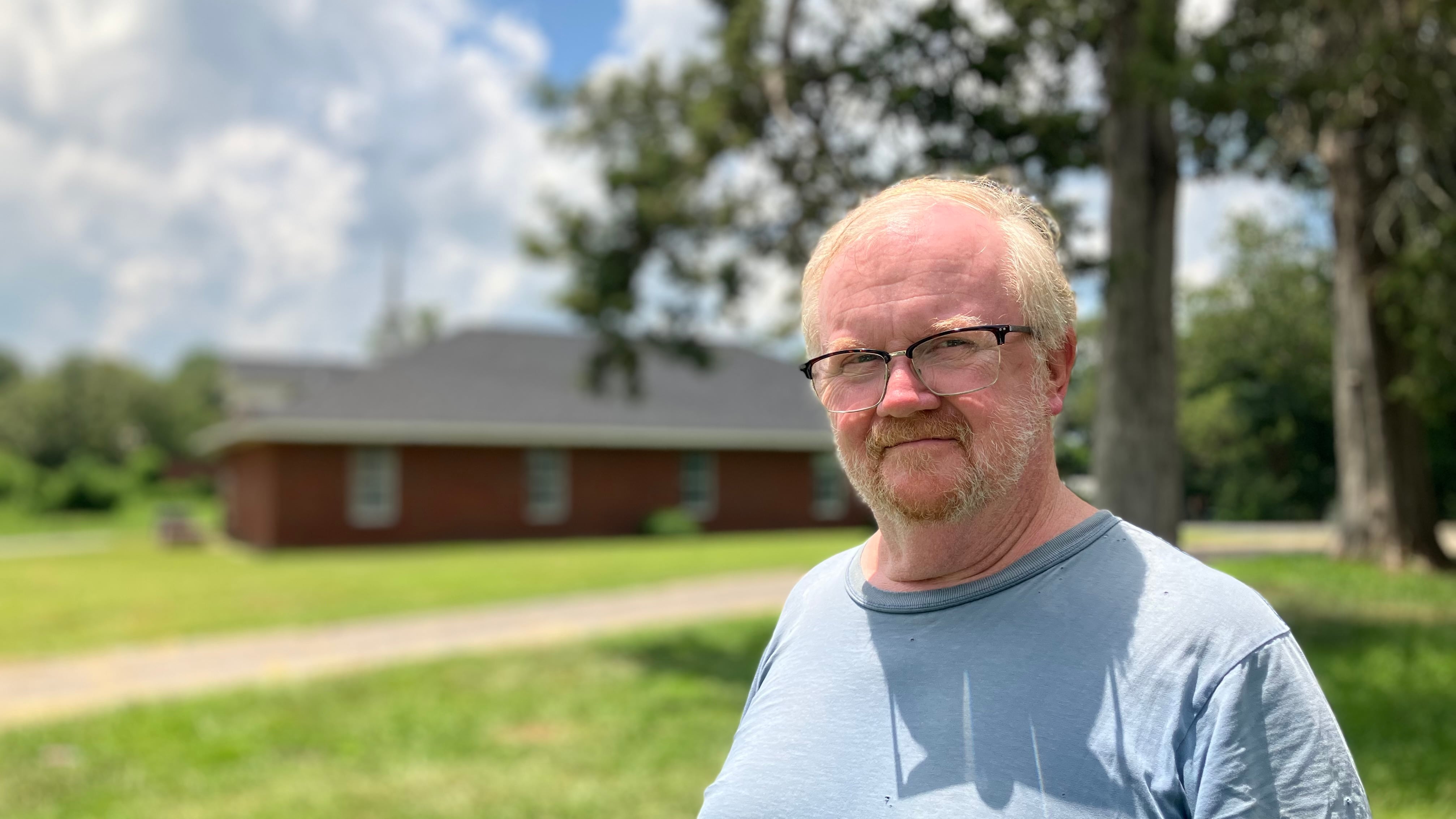
Dean Bonner is a Coast Guard veteran and longtime Camp Hill resident. He said he is hopeful for the town’s future. Alaina Bookman | [email protected]
“I care about the community,” Bonner said.
One of the things he loves most about the town, he said, is its history.
Founded in 1846, the First Universalist Church of Camp Hill is the oldest Universalist Church in the south. The red brick building stands tall and beautiful, though signs of the storm still mark its walls.
Tidwell said he helped to fix more than 100 leaks in the church’s roof after the storm. Plastic remains duct-taped and stapled over bright stained glass windows.
Camp Hill was also a cradle for the civil rights movement. The Sharecroppers Union emerged in 1931 in Tallapoosa County.
Residents said that before white flight and disinvestment hit the rural town in the 90s, Camp Hill was “the place to be.”
“We had a grocery school, we had a bank. We had a pharmacy here. We had a clothing store. We had a furniture store. We had football and basketball games. It was jumping,” said Thomas, who has lived in Camp Hill all her life. “Things changed a lot.”
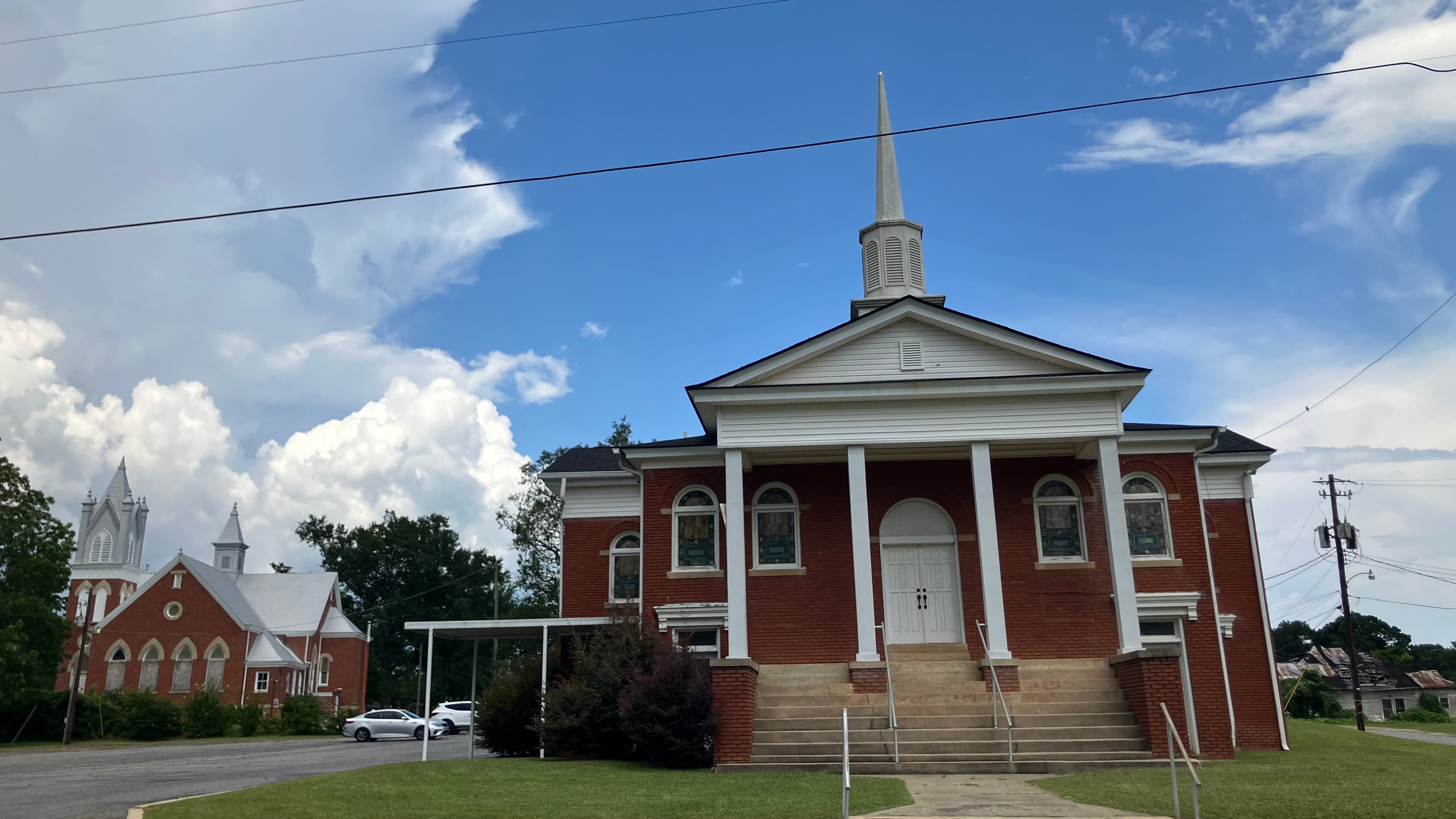
Founded in 1846, First Universalist Church of Camp Hill is the oldest Universalist Church in the South. Alaina Bookman | [email protected]
Today, many of those buildings are shuttered. But the community has a vision for the town’s future.
“It’s an interesting place and I think it’s got great potential and a lot to offer,” Bonner said. “We want to see it be at the best it can be.”
Residents are repairing the town’s community center.
Bonner is collecting donations to expand the Camp Hill Volunteer Fire Department.
Tidwell is working to repair a building to start a workforce training program for young adults.
“I’m hopeful about the future of this community,” Tidwell said.
“If we supply opportunity and hope within these communities, where a lot of these issues are a direct result of poverty, it will go away…We need resources.”
If you purchase a product or register for an account through a link on our site, we may receive compensation. By using this site, you consent to our User Agreement and agree that your clicks, interactions, and personal information may be collected, recorded, and/or stored by us and social media and other third-party partners in accordance with our Privacy Policy.
